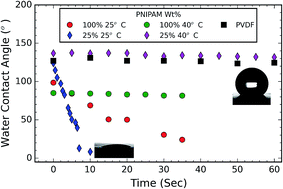Thermoresponsive electrospun membrane with enhanced wettability
Abstract
This study investigated the switchable wettability behavior of poly-N-(isopropyl acrylamide) (PNIPAM) and poly-(vinylidene fluoride) (PVDF) blend membranes that were fabricated using electrospinning. The wettability of the membranes was determined by water contact angle measurements. The wettability of the membranes was controlled by varying the concentration of PNIPAM in the blend. The results demonstrated that the addition of PVDF to the PNIPAM did not change the thermoresponsive behavior of PNIPAM. All PNIPAM/PVDF blend samples switched from hydrophilic to hydrophobic state when the temperature was increased from room temperature to 40 °C. However, blend samples with 25 wt% PNIPAM were demonstrated to be more hydrophilic and hydrophobic compared to other samples at room temperature and elevated temperature respectively. This was attributed to the phase separation of the polymers that resulted in domains with drastically different surface energies on the surface of the fibers.



 Please wait while we load your content...
Please wait while we load your content...